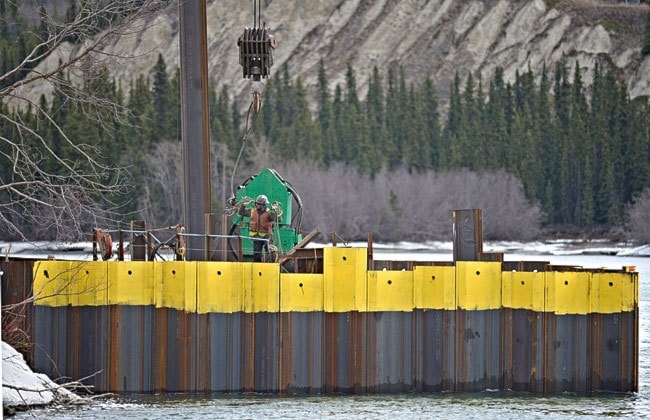During the Second World War, when many Yukoners and their neighbours in Alaska were worried about Japanese Zeros dive-bombing the coast, environmental protection took a back seat to wartime development.
Pearl Harbour was still fresh in everyone’s mind, and in the frenzied rush to build the Canol pipeline into Alaska, it’s not likely that people were too concerned about fuel that happened to spill on the banks of the Yukon River at the Canadian Oil refinery in Whitehorse.
But 70 years later, the old refinery site’s current owner - North 60 Petro - has inherited what is now a multi-million dollar environmental clean-up job.
North 60’s fuel storage facility is located at 146 Industrial Rd. After more than a decade of delays and regulatory hoop-jumping, the site is finally getting a proper cleaning.
Construction started earlier this month on a soil treatment facility and shoreline excavation project that the company hopes will get rid of the hydrocarbon contamination once and for all.
To do it, workers are driving a sheet-pile fence into the Yukon River a few metres from shore before digging up the contaminated shoreline. The fence will keep the contamination contained while the soil and water are placed in containers to be treated. The hole left behind will be back-filled with clean soil and a riprap barrier to prevent any future contamination from seeping into the river.
It’s a complicated procedure, and scientists from Pottinger Gaherty, the environmental firm assigned to monitor the project, aren’t sure exactly how long it will take to clean the soil.
“No one has X-ray vision,” explained Dave Meikli, one of the project’s supervisors. “It depends on what’s in the ground. There was gasoline and diesel spilled over the years, and we don’t really know what else.”
The soil will be treated with fertilizer and microorganisms, allowing bacteria to eat up the hydrocarbon contaminants, explained project manager Cory Cavazzi. The water, he said, will be pumped through a series of activated carbon filters to remove sediment and hydrocarbons, before being tested for clarity and finally released back into the environment.
“It also depends on the weather, too. If we get really good weather and we’re able to turn the soil every couple of weeks, that would help,” Cavazzi said.
The weather is a significant challenge for the project, especially because the relatively short summers and frigid winters mean there is only a short window for the decontamination work to take place.
Cavazzi said the work right now is restricted to digging up about 30 metres of shoreline. It’s a small-scale trial to make sure everything works, and find out how long it actually takes to clean the soil and water. The current excavation job is expected to be finished in July, and the whole project will likely take two to three years, Cavazzi said.
The site at 146 Industrial has had many tenants over the years, and no one knows exactly when who spilled what. After the short-lived Canol refinery shuttered, the site was a railway facility, a metal mining concentrate transfer station and a storage depot for Imperial Oil. What is known is that the previous owners left such a mess that a rusty-brown stain could be seen along about 200 metres of shoreline where the old refinery stood.
North 60 bought the property in 1995. In 1997, Environment Canada inspectors first noticed the mess, and soil samples showed oil and gas contamination was seeping out of the ground and into the river.
North 60 was ordered to clean the site up, but that was easier said than done. Regulatory and jurisdictional delays lead to a decade of inactivity on the project.
North 60’s general manager, Sharon Ness, said the company has been trying to make headway on the job since 2006, when North 60 first met with Environment Canada and the Yukon government to come up with a way to tackle the mess.
“It’s taken so long because there are so many regulatory agencies to go through,” Ness said.
In 2010, North 60 was fined $2,000 and ordered to make a $28,000 contribution to the environmental damages fund because the project was dragging on.
When it is finally complete, the shoreline will be rehabilitated, including pockets for fish spawning and other shoreline vegetation and wildlife.
Contact Jesse Winter at
jessew@yukon-news.com
